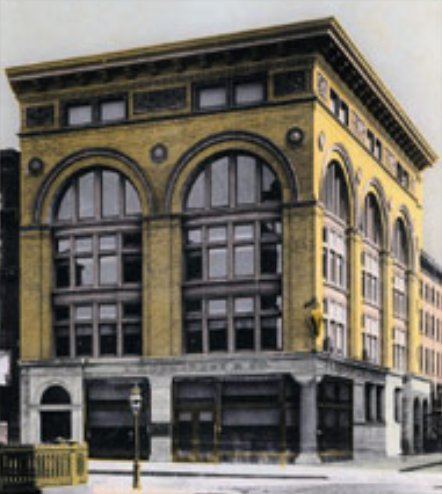 | ||
The Demarest building is a multi-purpose commercial building located at 339 Fifth Avenue in the borough of Manhattan, New York City (United States). It was built by Aaron T. Demarest in 1890 in the downtown commerce district to showcase the high-end carriages that he manufactured. The building is notable for being the first with an electric elevator.
Contents
Description
The Demarest building is situated on the northeast corner at Fifth Avenue and 33rd Street. It was designed by Renwick, Aspinwall & Russell. The building, with the first electric elevator, was on Fifth Avenue directly across the street from William Waldorf Astor’s mansion, where the Waldorf–Astoria hotels were built later. The Demarest building housed the high-end carriage manufacturer A. T. Demarest & Company. There were three mansion houses of brownstone construction previously at this location, with the addresses of 335, 337, and 339 Fifth Avenue.
The iron-framed building, built by Aaron T. Demarest, is four stories high and originally had a stone-clad base. The exterior brick is buff-colored and has terra cotta medallions and panels that accent the façade. The three-story arched openings are separated by brick pilasters on the front of the building. The architects designed these arches with windows so the interior's showrooms were illuminated with plenty of light. The original two-story windows were cast metal bays built within the building's front arches. This Beaux-Arts architecture style building with large arches is said to resemble Carnegie Hall.
History
In 1893 the Demarest building caught fire which destroyed many of the carriages. The Hotel Waldorf was across the street and the guests were awakened by the noise of the fire engines. They watched as the fire ravaged the building and its contents. At the time there were over 200 high-end carriages in the building valued at $150,000. The fire totally destroyed twenty carriages in the repair shop and damaged the others throughout the building to one degree or another. The fire was fueled by the seasoned wood, paints, oils, and varnishes used in production. The fire was not extinguished until almost 6 A.M.
The Demarest building was later converted to offices and work areas for small manufacturers. In 1913 Dr. Friedrich Franz Friedmann, who claimed to have a cure for tuberculosis, set up a medical practice on the second floor. The building's leasing agent would not allow the doctor to treat patients there and he ultimately moved to another location.
Teitelbaum & De Marinis had a business on the third floor from 1911 to 1914 producing high-end headwear. From 1917, the ground floor space was used by the Harris Store to sell high-end men's clothing. The firm of Flapper Coats moved into the building in 1919. Going into the 1920s much of the building's space was used by apparel firms like La Grecque Underwear Company. However Allied Steel and Supply Company did have offices there at the time. The hat manufacturer Hirschberg & Company was located in the building as was the decorative glassware company E. & J. Bass, Inc.
As of 2015, there were plans for developer Pi Capital Partners to replace the building and neighboring structures with a new residential tower.
